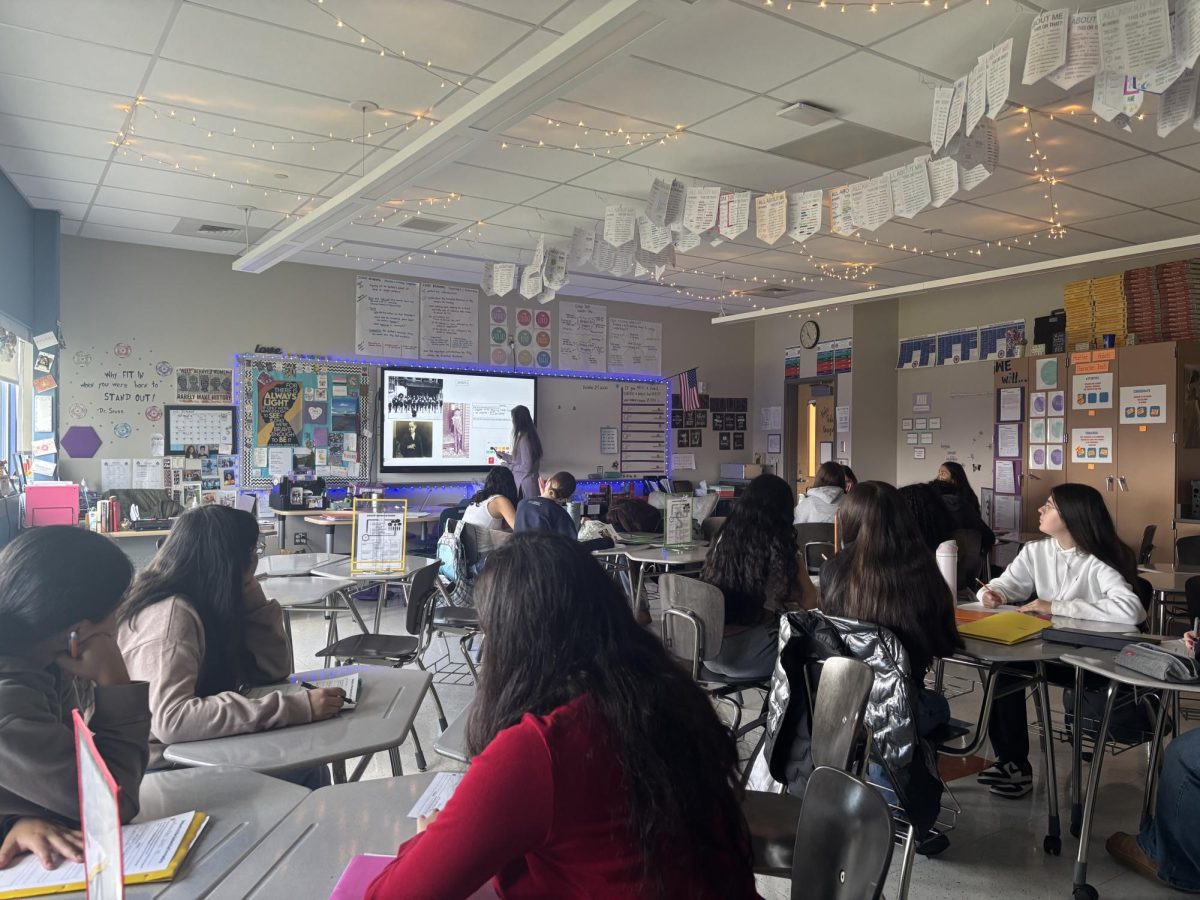Block scheduling to work with state’s increase in credits
Principal Dan Donovan and Assistant Principal in charge of the Freshman Academy, Kris Davidson, are looking at information for next year’s schedule.
June 6, 2018
A new era will begin in the fall when DHS switches the entire school to block scheduling. This is occurring because the state is changing graduation requirements for the class of 2023. That class will have to reach 25 credits instead of the 21 credits currently needed.
The problem with the current schedule occurs when students take a lunch and a science lab every year. Having a lab and lunch in one’s current schedule would allow them to make it exactly to 25 credits in the 45-minute periods currently scheduled. If a student fails one class he or she won’t be able to graduate on time.
Currently, 20 percent of students fail at least one class at DHS, meaning these students would have to be retained. Block scheduling gives students wiggle room and a second chance to succeed to graduate on time.
The Skinny 7
The schedule will involve 7 periods and flex: 1A, 1B, 2A, 2B, FLEX, 3A, 3B, 4AB. Periods 1A,1B, 2A and 2B will be 82-minute blocks. Flex will then occur for 40 minutes each day after the second block of the day. The 3A and 3B blocks will be 124 minutes because this block includes the three lunch waves, which will be about 30-35 minutes. Period 4AB, also known as the “skinny block,” will meet every day and will be 46 minutes long. With this new block schedule format, passing time will also increase to 6 minutes.
For shortened days, the schedule will be squashed and will skip over a day if there happens to be a snow day. Principal Dan Donovan says, however, if he needs to run two B days in a row at the end of the quarter he will with student notice.
The skinny block or 4AB was not what Donovan wanted. He wanted to hold a 4th block but the district informed him that the resources are not available to make that happen. It does not have the staff to run a 4th block and does not have the budget to hire the amount of teachers necessary.
Donovan said that the skinny block will have to work with the constraints. “The schedule looks as best a fit [as it can be], and does what’s best for the majority of kids. There are a lot of constraints: teachers can’t teach more than five classes and cannot have more than 130 kids.”
The Skinny 7 will bring some challenges to teachers during their planning time. Ray Coletti, an English teacher who worked on the block committee, said he isn’t a fan of the break in the continuity but also acknowledged that planning must be different. “You don’t want the teacher to think of block as teaching two lessons,” he said.
Kris Davidson is the assistant principal in charge of the Freshman Academy and a committee member who has put many hours into figuring all of this out. He echos Coletti’s words. “We don’t want [teachers] to take two 45-minute periods together, or cut the 82 minutes blocks in half. Skinny period can’t be the exact same lesson.”
He also stated that the freshmen will be in their out-of-team classes during the Skinny 7.
Donovan said he is hopeful that eventually the Skinny 7 will turn into a normal block. “This gives our kids more of an opportunity, and if we can find a way to make 8 (classes) we will do that.”
In fact, Donovan has already begun the process to achieve that. “We requested ( an increase in staff) but, [we haven’t gotten] our final number from Beaver Brook. We did a study: increase enrollment number multiplied by Increase in credits, and we would need about 24 new teachers. I know that the city and Board of Education cannot provide us that in one year, so we requested seven new teaching positions this year and hope to continue the trend every year after.”
Danbury is one of the few cities in Connecticut that is actually increasing in population, and therefore increasing in school enrollment while other districts are decreasing. Currently, DHS has an enrollment of 3,123, making it the largest in the state. Yet, the district is last in receiving education aid from the state.
Lunch waves
Another new concept included in block scheduling is lunch waves. These lunch waves will be about 30-35 minutes and will be during the 3A and 3B block.
There will only be three lunch waves, which is about 1,000 students on a lunch wave at a time. The main cafeteria was expanded to hold 800 students.
The Freshman Academy cafeteria will also be open to anyone bringing their lunch or purchasing ready-to-eat meals. Davidson said that the administration is going to have other options for students who don’t want a lunch to allow them to use the time as most beneficial.
Lunch waves may also present a challenge to those classes during the third lunch block. If the class has a middle lunch block the lesson will be interrupted for 30-35 minutes because of lunch
Davidson says it will “be a learning process to see what works best.” However, the current idea is to rotate lunch waves and determine lunch wave groups by sections of the school.
Flex period
In addition to the other changes, Advisory will be replaced by Flex Period, a 40-minute period every day.
Flex period was created with the idea of allowing students to seek extra scholastic help from teachers. Donovan said this is going to help students by freeing them from having to make up work during lunch or after school. [The goal is to] give kids more time everyday. I expect them to take advantage of this time, for them to meet with a teacher when they don’t understand what is happening, extra AP review, and so on.”
Students will have a “home” flex, in which they will meet every Monday. Through a software scheduling program, students will sign up for the places they will attend for the rest of the week. Each teacher can take a maximum of 15 students.
Barbara Bogart, science teacher, said that flex will benefit teachers and students, “What’s really nice about the flextime is that you can do more one-on-one instruction, assistance and help with students that need more time with you and who didn’t [understand something].”
Many students and teachers saw no benefit to Advisory and are happy to see DHS try something new after 10 years (Advisory was put into place during the last NEASC accreditation of the school). Erin Daly, president of NEA-Danbury, the teachers’ bargaining unit, said that many members questioned the value of Advisory.
“Many felt it was not beneficial learning time for students,” Daly said of Advisory. “While the new flex period may present some unique academic opportunities for students, we needed to make sure that the staff would be able to easily implement the change and still have time to plan, eat lunch and collaborate with other teachers. We are hopeful that this will be an improvement for teachers and students.”
Junior Martine Bernard said that the flex can’t be any worse than Advisory. “Anything will be more beneficial than Advisory because the lessons for Advisory are stupid and most Advisories don’t even do them anyways.”
Davidson also agrees that there is not a lot of value to Advisory. “ I’m beyond excited about flex period. Instead of one fits all, flex period will be more individualized. There are lots of opportunities to provide different things for all students.”
The administration has plans to eventually open this time slot for club and organization meetings. Donovan said that having clubs meet during the day will get more students involved because they won’t interfere with after school sports or work schedules.
Teachers’ concerns
The district asked NEA-Danbury to discuss changes in the teachers’ work day and teaching schedule. “Whenever our working conditions are going to be changed, we negotiate on behalf of teachers, to get the most reasonable and workable outcome,” Daly explained. “Our negotiating team works to ensure that our teachers are treated fairly and that the basic principles of our contract remain in place.”
She explained the union polled teachers and most answered they did not want to move to block scheduling. “That was a pretty big initial compromise,” she said. “The district can make these changes on its own but it is much better to have open, fair discussions to make the best possible outcome for our students and staff.
“In negotiations, there is always give and take,” Daly continued. “We feel we were able to negotiate some positives for our teachers. We were able to make sure evaluative standards were fair and that teachers maintained their prep time and other contractual rights.”
She added that the union also needed to ensure that teachers are treated fairly during the transition. “As teachers learn new teaching methods that best suit block scheduling, we had to assure that they would be evaluated fairly by administration. We also wanted to make sure that teachers are provided with quality professional development to help them transition.”
Teaching in a block
As Daly said, another challenge is preparing the faculty to plan and teach for block. The administration is relying on the Freshman Academy teachers to help out with this. They have been teaching block for seven years now. Davidson remembers the smooth shift they made going from 45 minutes to 90 minutes and said he believes the rest of the building will follow suit.
DHS was planning on using a Professional Development day to help make the transition smoother for the other teachers. The freshmen teachers were going to present various ways to keep kids focused and explain their own experiences and lessons from block scheduling. This had to get rescheduled because of the tornadoes and macrobursts that came through the area in May. Although a new date has yet to be set, Davidson is certain this will occur even if it happens to be at the start of the 2018-2019 school year.
A major concern from students is staying focused during the 82-minute classes. Many students say that they begin to zone out after 45 minutes of that specific course. Brandon Cubberly, junior, says no matter the class is about he can’t stay focused. “I don’t like how long blocks are. Personally, I start to get distracted when I’m in the same class for more than an hour at a time, regardless of what class it may be.”
Bernard suggests that teachers switch up their lessons and use a variety of activities. “Doing the same structure everyday will be [too much in a block], Teachers are going to have to find more than just Power Point presentations and dry worksheets in order to keeps kids awake and engaged.”
Davidson acknowledges this issue: “We don’t want teachers to sit there and present for 90 minutes.” He mentioned that this was going to be a part of the discussion at the Professional Development day.
Even though teachers will see students for longer periods of time, the actual time in class throughout the whole year will decrease, even more so for the science classes because of their added lab period.
Bogart recognizes this as one of the only weakness’ of block scheduling. “The downside of the block scheduling is everyone is losing some contact time with the students over the year.”
She explains that losing a lab period won’t affect the labs done but will affect the learning time, “You can do a lab every single time; you don’t necessarily have to wait for the lab day. That will be a bigger issue with the AP classes because they have two, That piece will be tricker. On the teacher end, we are going to have to get creative with how we present the info. It’s going to put more of a burden on the students and they are going to have to do more work on the off days.”
Daly also notes that there isn’t data that is largely in favor of block scheduling. “I will say, there is very little conclusive national research to prove that block scheduling produces better student learning outcomes.”
Ultimately, teachers and students are excited to see what block schedule brings to the school and the impact it will have on students. Although Cubberly isn’t a fan of the block schedule, he sees it being useful for the future. “It can be beneficial for those students who are planning on going to college. Most colleges run on a block schedule, so I think doing blocks in high school can help prepare students for college.”
Erica Keane, family and consumer science teacher, recently arrived at DHS in March from a school with block scheduling. “I love the opportunity to teach content and then play with it and use it all in the same class.” She states that the longer periods allow time time to deepen the concept of the content.
The union, Daly said, is hopeful to see improvements from this new schedule. “Block scheduling may allow for improved small group instruction, differentiation and the ability for teachers and students to delve deeper into a lesson,” Daly said. “Project-based learning and collaborative learning may also be enhanced by longer teaching and learning blocks. In the coming years, NEA Danbury will monitor the student learning data closely to see if this is a productive change for DHS students and staff.
The implementation of this new schedule will present challenges and triumphs going into the 2018-2019 school year, but administrators say they are all in.
“There’s going to be an adjustment period, but I’m not doing this because I want to create more work for myself,” Donovan said. “ I’m doing it because I think it gives students more opportunities to achieve.”





















Mike Caldwell • Jun 9, 2018 at 2:59 pm
And there we have it… a teacher already confirming that this will result in even MORE HOMEWORK for already heavily burdened kids:
“It’s going to put more of a burden on the students and they are going to have to do more work on the off days.”
Once again punishing the good students so that the bad students have it even easier. What ever happened to kids repeating classes in Summer School? Are kids going to have to give up extra curricular activities just to keep up with their homework load and still have enough time to sleep?
And as for helping kids adjust to college schedules, that’s a load of bunk. College schedules are all over the map. Some classes meet every day like the old DHS schedule. Some meet 2 or 3 times a week like a block schedule. Some only meet at night. Some only meet once a week. My oldest is going into his senior year of college and has had ALL of those for class options in his first three years. Block scheduling does nothing to help kids adapt to college.